The T19 Howitzer Motor Carriage (HMC) was a 105 mm (4.1 in) howitzer, mounted on a M3 Half-track chassis, with 342 converted between January 1942 and April 1942 by Diamond. They used by the US Army alone in World War II as self propelled artillery, making their combat debut after Operation Torch in north Africa. It was defended by an air-cooled .50 in (13 mm) M2 machine gun. It took part also in the Allied invasion of Sicily and the Italian Campaign, ending with the invasion of southern France in August 1944 and soldiering into southern Germany until the end of the war in Europe.
The prototype was assembled and tested at Aberdeen Proving Ground showing that its M2 recoil mechanism and other parts of the M2 howitzer carriage could be mounted quickly following a procedure without too much modifications. Tests showed the gun carriage proved fragile on bumpy terrain and needed either to be better suspended or to reinforcing the frame and redesigning the mount.
"The other modification was to have removable headlights were due to muzzle blast damage. It was introduced on later production models, as the shield, foldable, also added during testing. The gun faced forward with a total traverse of 40 degrees total (20 either side) and an elevation up to +35 degrees. The armored windshield cover was remounted to fold onto the hood ad protect the crew against the blast. It was open on the regular M3.
Once accepted for production, the prototype was shipped to Diamond T to be copied, with first production vehicle delivered by January 1942 for a grand total of 324 T19s made until it ended in April 1942: 38 by February 1942, 136 by March 1942 149, by April 1942. This short run was considered a stopgap before the introduction of fully tracked systems such as the M7 Priest and M8 Scott (the latter having the M1 mountain howitzer).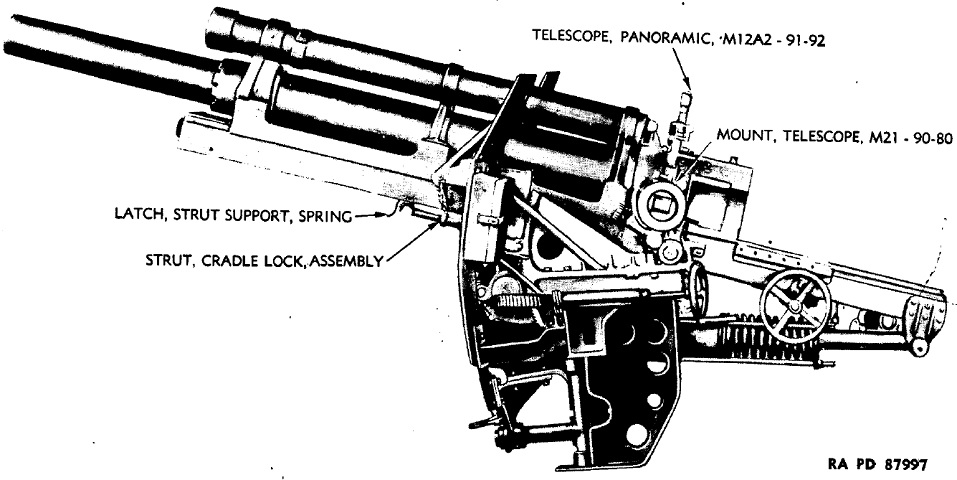
The main armament was the 105 mm M2A1 howitzer installed behind. It had only eight ready rounds of ammunition, wit extra vehicle carrying the remainder, passed on by the loaders.
The M2A1 Howitzer, still used today as the "M101 105mm Light Howitzer, Towed", is a remarkable piece of orednance designed to replace the old WWI derived park still in use when the war broke down in 1939. It was designed on 1940 at the Rock Island Arsenal and produced from 1941 to 1953 by Kia Machine Tool. 10,200 made in all. It saw action in WW2 on all fronts, Korea, Vietnam, and up to the Iran-Irak war, and up to the present Russo-Ukrainian War and Yemeni Civil War.
The 105 mm (4.1 in) M2A1 weighted 4,980 lb (2,260 kg) for 19 ft 6 in (5.94 m) overall, 7 ft 7 in (2.31 m) L/22 for the barrel alone. It was 5 ft 8 in (1.73 m) high, and had an optional shield welded onto the mount base. It fired a 105×372 mm R shell at 1,550 ft/s (472 m/s). It used a Breech with Horizontal-block and it had an Hydro-pneumatic, constant course over 42 in (110 cm). It was able to elevate up to 65° (1,156 mils) but the mount only authorized a ±23° (±409 mils) traverse to a max range of 7.00 mi (11,270 m)
It was protected up close by a single .50 caliber (12.7 mm) M2 Browning machine gun coming with 300 rounds of ammunition.
The last ones used in Italy also saw sometimes heavy action, such as the cannon company of the 16th Infantry Regiment, which halted a German tank attack, knocking out six tanks, for the loss of a single T19, being later awarded the Presidential Unit Citation. A few were still found in 1945 in southern France and fought near Colmar, and perhaps in Bavaria in April-May. It was Declared obsolete in July 1945 and mong those returned that were simply written off and scrapped, those in good shape, 90 were taken in hands by Brown & McLaughlin and converted back as M3A1 Half-tracks.
Chamberlain, Peter; Ellis, Chris (1969). British and American Tanks of World War II. New York, NY: Arco Publishing Inc.
Doyle, David (2011). Standard Catalog of U.S. Military Vehicles (Second ed.). Iola, WI: Krause Publications.
Green, Michael; Green, Gladys (2000). Weapons of Patton's Armies. Minneapolis, MN: MBI Publishing Company.
Green, Michael (2014). American Tanks & AFVs of World War II. Oxford, UK: Osprey Publishing.
Hunnicutt, R. P. (1992). A History of the American Light Tank: Stuart. Navato, CA: Presidio Press.
Hunnicutt, R. P. (2001). Half-Track: A History of American Semi-Tracked Vehicles. Navato, CA: Presidio Press.
Ness, Leland (2002). Jane's World War II Tanks and Armored Fighting Vehicles. London, UK: HarperCollins.
Zaloga, Steven J. (1994). M3 Infantry Half-Track 1940–1973. Oxford, UK: Osprey Publishing.
Zaloga, Steven (2014). Armored Attack 1944: U.S. Army Tank Combat in the European Theater from D-Day to the Battle of the Bulge. Mechanicsburg, PA: Stackpole Books.
wardrawings.be
afvdb.50megs.com
militaryfactory.com
historyofwar.org
en.wikipedia.org
T19_Howitzer_Motor_Carriage
Development of the T19 HMC
In the autumn of 1941 the Armored Force rapidly expanded, and at the time there was no self-propelled artillery in service. Instead of a full-track chassis already uregently required for tanks, more available vehicles were preferred, and already available. The M3 Half-track was selected for the task, to be mated to the newly produced 105 mm M2A1 howitzer. This was first suggested in September 1941, but the situation bounched again and the requirement was eventually approved by the Adjutant General. Construction of a prototype was authorized by OCM 17391 on 31 October 1941 under the designation "105 mm Howitzer Motor Carriage T19".The prototype was assembled and tested at Aberdeen Proving Ground showing that its M2 recoil mechanism and other parts of the M2 howitzer carriage could be mounted quickly following a procedure without too much modifications. Tests showed the gun carriage proved fragile on bumpy terrain and needed either to be better suspended or to reinforcing the frame and redesigning the mount.
"The other modification was to have removable headlights were due to muzzle blast damage. It was introduced on later production models, as the shield, foldable, also added during testing. The gun faced forward with a total traverse of 40 degrees total (20 either side) and an elevation up to +35 degrees. The armored windshield cover was remounted to fold onto the hood ad protect the crew against the blast. It was open on the regular M3.
Once accepted for production, the prototype was shipped to Diamond T to be copied, with first production vehicle delivered by January 1942 for a grand total of 324 T19s made until it ended in April 1942: 38 by February 1942, 136 by March 1942 149, by April 1942. This short run was considered a stopgap before the introduction of fully tracked systems such as the M7 Priest and M8 Scott (the latter having the M1 mountain howitzer).
Design
The T19 Howitzer Gun Motor Carriage is based on the M3 Half-track, the major change being the howitzer emplaced on the tracked portion of the frame, nehind the cab. Its dimensions were close to the original at 20 ft 2 inches long, 7 ft 3.5 inches wide, but 7 ft 8 inches high. For an overall weight of 9.54 short tons. The only change was the mount installed on the rear open cab. The original mount was cut down to its pivot and the original legs and axle were emoved. It was then bolted on a plate welded on the floor forward. Between the recoil, space, tooling and spare ammunitons, space was scarce inside.Mobility
The T19 HMC was powered by a White 160AX engine. This was a six-cylinder gasoline engine had a capacity of 386 in3, and a compression ratio of 6.3:1. It was rated for 147 hp, for a road speed of 45 mph as the power-to-weight ratio was 14.7 hp/ton. The suspension was the same also as the M3 half track: There were semi-elliptical longitudinal leaf springs for forward wheeled axle, and vertical volute springs for the rubber tracks. The front drive sprocket, and rear idler, used as tensioner with an hydraulic piston. The narrow track was supported by a single return roller on top of the VVS, and gound contact was made by a bogie comprising eight doubled, rubberized small road wheels per side.Protection
The T19 HMC had a crew of six protected behind 0.5 inch (12.7 mm) on the nose glacis and windshield but only 0.25 inches (6.35 mm) on the side walls and back. Meaning AP bullets could pierce through with ease. The commander usual sat with the driver in the cabin forward during transit, and joined the crew when starting battery fire, with two gunners for elevation and traverse either side, and two or three loader.Armament

The main armament was the 105 mm M2A1 howitzer installed behind. It had only eight ready rounds of ammunition, wit extra vehicle carrying the remainder, passed on by the loaders.
The M2A1 Howitzer, still used today as the "M101 105mm Light Howitzer, Towed", is a remarkable piece of orednance designed to replace the old WWI derived park still in use when the war broke down in 1939. It was designed on 1940 at the Rock Island Arsenal and produced from 1941 to 1953 by Kia Machine Tool. 10,200 made in all. It saw action in WW2 on all fronts, Korea, Vietnam, and up to the Iran-Irak war, and up to the present Russo-Ukrainian War and Yemeni Civil War.
The 105 mm (4.1 in) M2A1 weighted 4,980 lb (2,260 kg) for 19 ft 6 in (5.94 m) overall, 7 ft 7 in (2.31 m) L/22 for the barrel alone. It was 5 ft 8 in (1.73 m) high, and had an optional shield welded onto the mount base. It fired a 105×372 mm R shell at 1,550 ft/s (472 m/s). It used a Breech with Horizontal-block and it had an Hydro-pneumatic, constant course over 42 in (110 cm). It was able to elevate up to 65° (1,156 mils) but the mount only authorized a ±23° (±409 mils) traverse to a max range of 7.00 mi (11,270 m)
It was protected up close by a single .50 caliber (12.7 mm) M2 Browning machine gun coming with 300 rounds of ammunition.
specifications | |
| Dimensions (L-w-H) | 20 ft 2 in x 7 ft 3.5 in x 7 ft 8 in (6.15 x 2.223 x 2.34 m) |
| Total weight, battle ready | 9.54 short tons (8.65 t) |
| Crew | 6 |
| Propulsion | White 160AX 386 in3 6-cyl. 147 hp (110 kW), pw 14.7 hp/ton |
| Top speed | 45 mph (72 km/h) |
| Suspensions | Semi-elliptical longitudinal leaf spring, single vertical volute spring bogie |
| Range | 60 US gal (230 L): 200 mi (320 km) |
| Armament | M2A1 105 mm Howitzer (8 rounds), .50 cal M2 HMG |
| Armor | Windshield 0.50 in (13 mm), sides/rear 0.25 in (6.4 mm) shield 0.25 in (6.4 mm) |
The T19 HMC in action
The T19 HMC served in the Tunisia Campaign in North Africa from Operation Torch in November 1942 until the capitulation of the resent axis forces in Tunis by early 1943. Most battalions headquarter platoons fielded the vehicles, as well as "cannon companies" associated to infantry divisions, like the big red one. The T19 was still used in Sicily, and then Italy in early 1944, but already replaced in armored divisions by the M7 Priest whiched fielded the same 105 mm howitzer but was fully tracked.The last ones used in Italy also saw sometimes heavy action, such as the cannon company of the 16th Infantry Regiment, which halted a German tank attack, knocking out six tanks, for the loss of a single T19, being later awarded the Presidential Unit Citation. A few were still found in 1945 in southern France and fought near Colmar, and perhaps in Bavaria in April-May. It was Declared obsolete in July 1945 and mong those returned that were simply written off and scrapped, those in good shape, 90 were taken in hands by Brown & McLaughlin and converted back as M3A1 Half-tracks.
Read More/Src
Books
Berndt, Thomas (1993). Standard Catalog of U.S. Military Vehicles, 1940–1965. Iola, WI: Krause Publications.Chamberlain, Peter; Ellis, Chris (1969). British and American Tanks of World War II. New York, NY: Arco Publishing Inc.
Doyle, David (2011). Standard Catalog of U.S. Military Vehicles (Second ed.). Iola, WI: Krause Publications.
Green, Michael; Green, Gladys (2000). Weapons of Patton's Armies. Minneapolis, MN: MBI Publishing Company.
Green, Michael (2014). American Tanks & AFVs of World War II. Oxford, UK: Osprey Publishing.
Hunnicutt, R. P. (1992). A History of the American Light Tank: Stuart. Navato, CA: Presidio Press.
Hunnicutt, R. P. (2001). Half-Track: A History of American Semi-Tracked Vehicles. Navato, CA: Presidio Press.
Ness, Leland (2002). Jane's World War II Tanks and Armored Fighting Vehicles. London, UK: HarperCollins.
Zaloga, Steven J. (1994). M3 Infantry Half-Track 1940–1973. Oxford, UK: Osprey Publishing.
Zaloga, Steven (2014). Armored Attack 1944: U.S. Army Tank Combat in the European Theater from D-Day to the Battle of the Bulge. Mechanicsburg, PA: Stackpole Books.
Links
missing-lynx.comwardrawings.be
afvdb.50megs.com
militaryfactory.com
historyofwar.org
en.wikipedia.org
T19_Howitzer_Motor_Carriage
Model Kits
On scalematesGallery
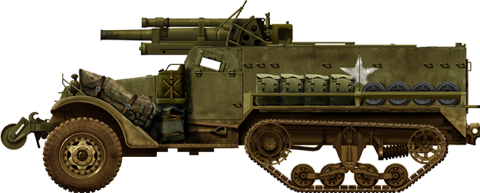
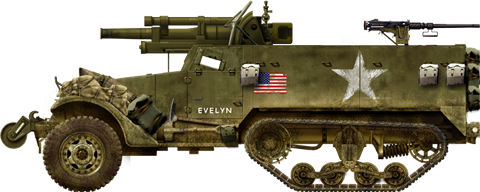
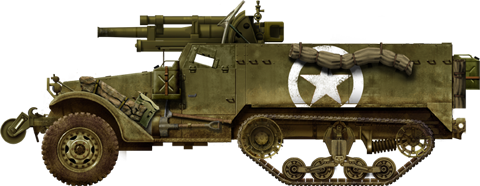
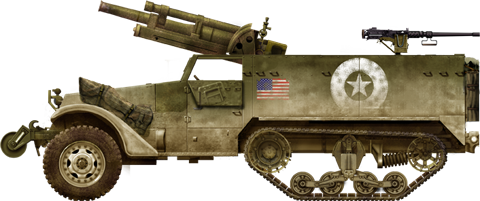
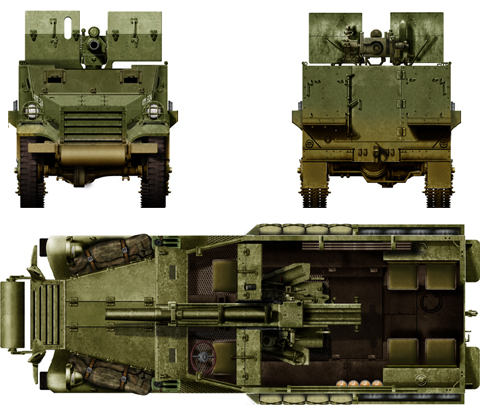
T-19 HMC, top, back and front views
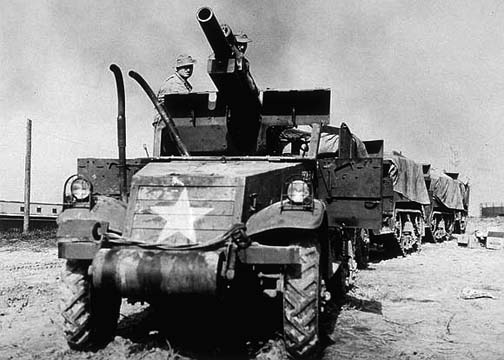
T19 HMC 20/10/1942
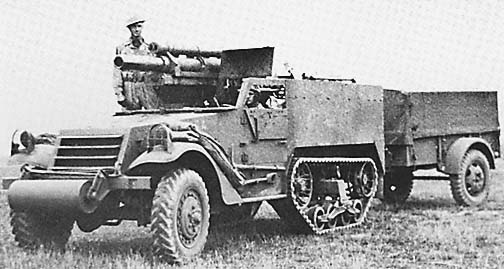
T19 with ammunition trailer
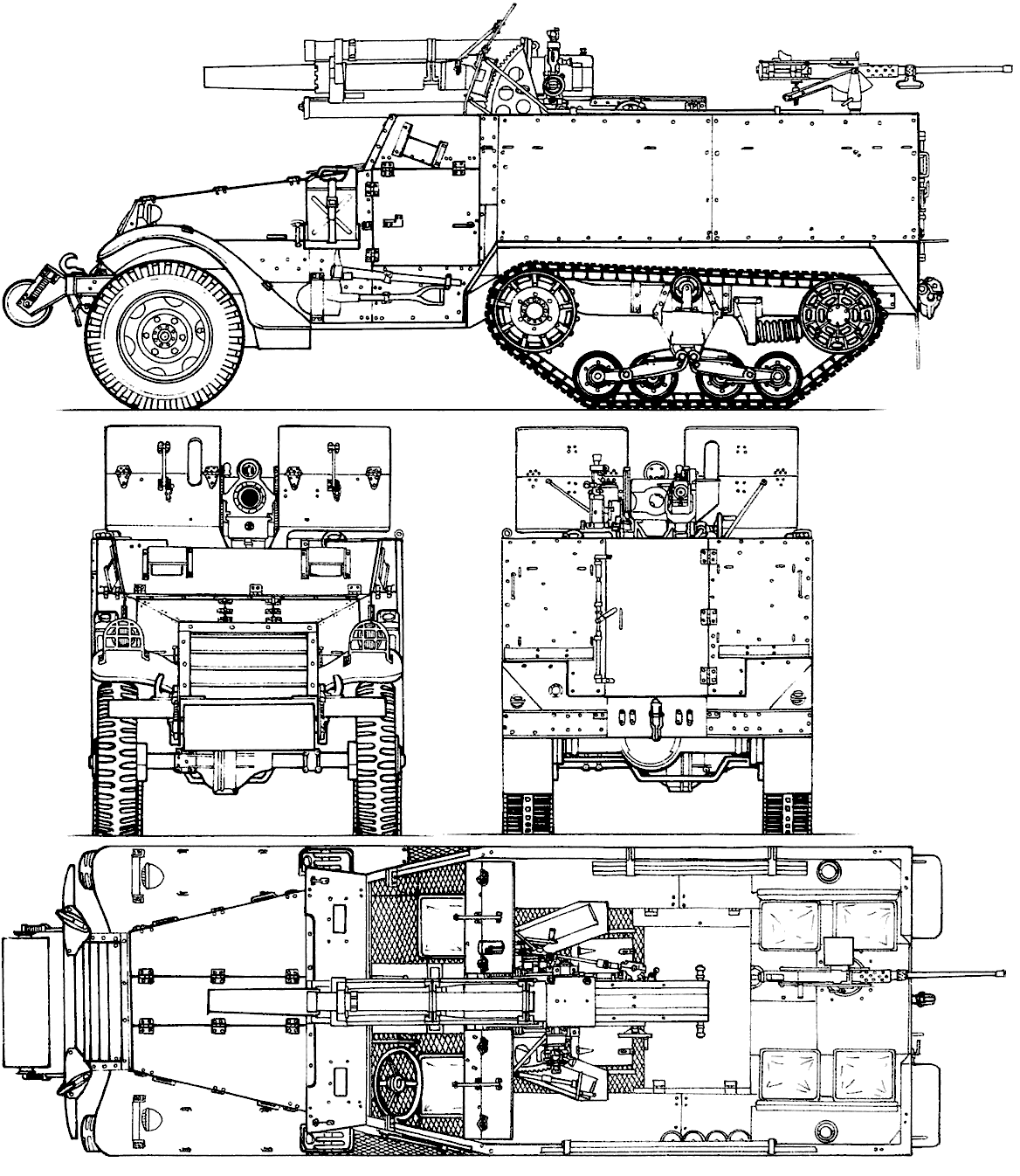
T-19 HMC blueprint

WW2 Tanks




























WW2 tanks posters

All Tiger tanks liveries.

Panther liveries and variants

WW2 Armour - All tanks











Tanks aces and single tanks series

Find more there

Museums, Movies, Books & Games
The Tanks and Armor in pop culture
Tanks and armored vehicles in general are only really grasped when seen first person: The mass, the scale, it's all there. Explore also the way tanks were covered in the movie industry, in books and in video games.Movies:
Best tanks movie on warhistoryonline.com
On imdb.com
On bestsimilar.com/
miltours.com
liveabout.com/
watchmojo.com
Video Games:
pcgamesn.com
historyhit.com
levvvel.com
vg247.com/best-tank-games
mmobomb.com/
alienwarearena.com

